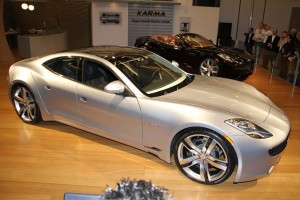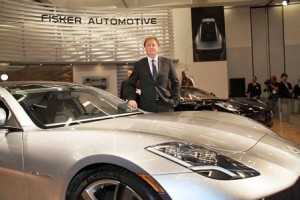The first Fisker Karma, a high-performance plug-in hybrid, will reach dealer showrooms in September 2010, said the company’s eponymous founder Henrik Fisker.
That’s the better part of a year behind the initial estimates of the California-based start-up but considering Fisker Automotive launched just two years ago, few expected the company could meet its initial, ambitious timetable.
Karma is a two-door sports car, but under the skin, it features a hybrid-electric drivetrain based around a large, 22 kwH lithium-ion battery. That’s enough to yield 50 miles of driving on battery power alone, Henrik Fisker told reporters during a news conference at the Los Angeles Auto Show, and to propel the vehicle from 0 to 60 in just 6 seconds, with a top speed of 125 mph.
When the battery runs down, Karma will be able to keep rolling, using a backup internal combustion engine.
“This,” said Fisker, “is about environmentally-friendly cars without compromise.”

The 2011 Fisker Karma will get 50 miles on battery power alone, but should launch from 0 to 60 in 6 seconds, with a 125 mph top speed.
With a base price of $87,900, the Karma is expected to be a relatively low-volume offering. Worldwide sales, the company estimates, should reach a maximum 11,000 annually, even after the addition of a third body style variant. Fisker plans to launch with both a coupe and convertible version, and company sources say the next spin-off will be a crossover.
The three-variant strategy will be repeated when Fisker Automotive launches its second product line, in 2012. Codenamed Project Nina, it will cost a little more than half as much as the Karma, Fisker promised.
The second line is to be assembled at a former General Motors assembly plant, in Delaware, that Fisker is purchasing with the help of a $528 million loan from the Department of Energy. The company’s target is to produce as many as 100,000 Nina-based vehicles annually.
(For more on Fisker Automotive’s plan, Click Here to read a Q&A with Henrik Fisker.)

